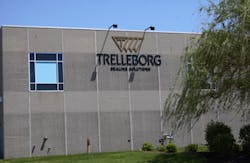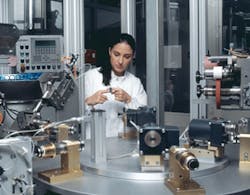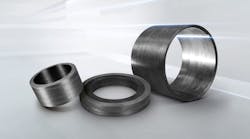Whether it’s reducing energy use, recycling waste materials or designing more energy-efficient products, "green" manufacturing is on everyone’s minds.
For the last five years the Trelleborg Sealing Solutions facility in Fort Wayne, Ind., has taken a systematic approach toward continuous improvement. And it has led to impressive results: a savings of about $850,000 just by eliminating material waste. Part of a Sweden-based global engineering group, Trelleborg Sealing Solutions is a worldwide supplier, developer and manufacturer of precision seals for the industrial, aerospace and automotive markets.
"We have been on a five-year journey that continues with a vision of growth and a plan for continuous improvement," says Tim Stumph, general manager of the Fort Wayne plant. "A 2010 jump in raw material prices really motivated our efforts. The cost of our main material, the synthetic polymer polytetrafluoroethylene (PTFE), jumped 300 percent."
Stumph and his team’s efforts began in 2008 when they examined the plant’s overall performance and initiated 21st-century manufacturing techniques to support its strategy.
"Waste-reduction efforts shifted into high gear," Stumph says. "We started to use Six Sigma to drastically reduce our material content. We had a number of ongoing projects that all involved reducing variations." As is well known, Six Sigma is a set of statistically based tools and strategies to improve process outputs in manufacturing.
Higher velocity = quicker OTD
Stumph says making it easier to do business with a company is one of the fastest ways to increase a plant’s throughput. Two customer services that significantly impact performance are quote-response time and on-time delivery (OTD).
In fact, believes the Trelleborg executive, in its field, the first company to return a quote to a customer is usually rewarded with the purchase order. One of the team’s early successes was to reduce its quote time from about six days to less than one day. Today they manage it in four hours.
The next area they looked at was OTD. "We were adequate," Stumph says, "and that is not a word in my dictionary. In everything we do we focus on velocity, trying to increase speed in our many different manufacturing processes.
"In order to increase speed you have to reduce waste. OTD was a problem. It was taking about 28 days to get a product from the floor to shipment. We were 50 percent on time to the customer, at best. Then we started to focus on velocity. As you increase velocity, you will greatly enhance OTD."
Trelleborg used a Value Stream Map, a lean-manufacturing technique that highlighted the parts of the manufacturing process that added value and those that did not.
"One of the first areas of focus is usually inventory. In areas such as compounding, blending and machining each workstation produces in a degree of isolation, and is not concerned with the process in the next cell. So the first area on which we worked was decreasing inventory."
By the end of 2008, it took only 21 days to get product out the door, but OTD wasn’t significantly impacted. "Every time we made a change, we would do a new Value Stream Map to track where the next constraint was slowing production," Stumph says. "We kept on looping through this process. We have been doing that now for about five years, and today we are down to four to six days from our original 28 days. Our current OTD is 99.7 percent and we are really proud of this achievement."
"I think what happens is that most people focus on a Value Stream Map, but we actually do it from a velocity perspective since this is something everyone in the process understands easily: If I do this, velocity will go down. If I do that, it will go up."
Zeroing in on potential waste
The potential for waste at the Trelleborg plant has several sources: delay, inventory mismanagement and scrap from overproduction. As work continues toward standardization, the company reduces process variation.
"Product quality in this facility has never really been a problem," Stumph says. "What goes out the door has always been good, but to get there we did overproduce."
Quality means reducing process variations. "If I am reducing my process variations, the possibilities for producing poor quality are less," says Stumph. "The results were amazing when we challenged our operators to try to do their setup with one piece and no more. This forced our operators to focus on performance and we supported them with training. As you focus on velocity, it affects everything. I am not saying that you work faster necessarily, but your output is better."
Good for the plant, good for the customer
Examples of how process improvement and eliminating material waste go hand-in-hand include the following from the Trelleborg Sealing Solutions plant in Fort Wayne, Ind.
- "Thin the walls": Most of the products manufactured at the plant are made of tube or bar. A model was developed that detailed the different shrink rates and projected the optimum wall thickness of the material, resulting in less raw material waste. After understanding and eliminating the variation on one product, the model can be instanced on all similar diameters and compounds throughout the facility.
- Saving on raw material: On large-diameter products, the Fort Wayne facility uses waste material instead of brand-new, or virgin, material on the portion of the part that will not be used or "chucked" on the machining center. By using chips or shavings from previously made products, new PTFE is added, compressed and sintered, which forms a bond between the two dissimilar materials. This change has led to significant raw material savings.
- Eliminating oxidations: Oxidations are visual variations that the customer does not want to see even though they don’t affect the product’s function. At the facility, these would typically be sorted out before delivery and scrapped. Today, by changing the type of ovens used in the process from electric to gas, the facility eliminated the oxidation. This knowledge was shared with Trelleborg’s sister facility in Helsingor, Denmark, and has led to increased cooperation and mutual benefits for the two facilities.
Now that the plant is stabilized, Trelleborg plans to move to the next phase: a customer-focused new-product development cycle. They’ll interact with customers more effectively so they can identify what their process problems are and how to help.
"When we launch a new product, the entire cycle will start again: stabilize and standardize, then reduce process variation. We continually educate to enable us to perform at increasing levels of efficiency. This is what manufacturing excellence is all about to us," Stumph concludes.
Trelleborg Sealing Solutions has five manufacturing facilities in the U.S.: Fort Wayne, Ind.; Broomfield, Colo.; Streamwood, Ill.; and Hudson and Northborough, Mass.



